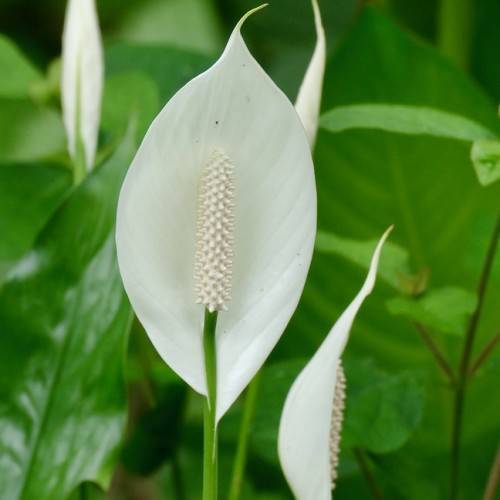
peace lily
Spathiphyllum cvs.
Cycle:
Perennial
Watering:
Frequent
Hardiness Zone:
6
Flowers:
Flowers In Spring
Sun:
Full sun, Part sun/part shade
Soil:
Humus rich, Well-drained
Fruits:
Fruits In Autumn Ready In
Edible:
Yes
Leaf:
Yes
Growth Rate:
Moderate
Maintenance:
Low
Drought Tolerant:
Yes
Thorny:
Yes
Care Level:
Medium
watering
It is important to water Pink Pagoda mountain ash (Sorbus hupehensis 'Pink Pagoda') regularly, but not too heavily. During the summer months when the plant is in active growth and flowering, water it once or twice a week, allowing the top inch of soil to dry between waterings. During the winter months, reduce watering to once every 2 weeks. Make sure the soil never becomes soggy, and always water in the morning so the foliage has time to dry off before evening. When temperatures turn cold and rainfall is sparse, resume summer-level watering to prevent the plant from becoming stressed. It is important to note that in times of extreme drought, these plants should not be watered at all.
sunlight
Pink Pagoda mountain ash plants, which are better known as Sorbus hupehensis 'Pink Pagoda', usually prefer to be planted in areas with a good amount of sunlight. Ideally, they would be planted in a place that receives full sun (around 6 to 8 hours of direct sunlight each day) during the spring and summer months, but can tolerate some shade in the afternoons. Part sun (4 to 6 hours of direct sunlight per day) is usually satisfactory in the autumn and winter months. If possible, it is best to avoid planting in shaded areas where the plant would not receive any direct sunlight for long periods.
pruning
Pink Pagoda mountain ash should be pruned during the winter months while the tree is dormant. Pruning should be light; remove dead or damaged branches and lightly shape the branching structure. Avoid pruning too much or too often as this could weaken and damage the tree.
Propagation
Season
Hardiness Map
FAQ
Are peace lily plants toxic to pets?
Yes, peace lily plants are toxic to pets. Both cats and dogs can suffer from vomiting, drooling, and difficulty swallowing if they ingest any part of the peace lily plant. In severe cases, pets may also experience difficulty breathing or an increased heart rate due to the ingestion of the poisonous plant. If you believe your pet has ingested any part of the Peace Lily, it is advisable to contact a vet immediately.
Can peace lily plants bloom indoors?
Yes, Peace Lily plants are well suited to indoor conditions and they do bloom indoors. The Peace Lily plant is easy to care for, and a small Peace Lily in a pot will typically bloom one to two times per year. The Peace Lily flower is white and smells slightly sweet, making it a nice addition to any home. Keep in mind that the Peace Lily requires a lot of humidity, so it may be necessary to mist it occasionally and place near a humidifier.
Should I place my peace lily in direct sunlight?
No, peace lilies don't prefer direct sunlight and should not be placed in it. Ideally, they should be placed in indirect or filtered light, like near a south-facing window. This will provide enough light for the plant while protecting it from the harsh sun, which could cause its leaves to burn and turn yellow.
Is the average lifespan of a peace lily known?
The average lifespan of a peace lily is not definitively known, although generally the flowers can survive for up to 10 years or more. To ensure the longevity of a peace lily, it is important to maintain regular watering and light exposure to keep the plant healthy and prevent it from wilting. Additionally, if the peace lily is regularly pruned and groomed, with dead leaves and old flowers being removed, it can help to extend the life of the flower.
should I water my peace lily plant every day?
No, you should not water your peace lily plant every day. These plants prefer to have their soil on the drier side and are prone to root rot if overwatered. Water your peace lily about once a week, and be sure to monitor the top inch of the soil for dryness before watering. If the top inch of soil is still damp, wait a few days before you water your plant to prevent overwatering.
